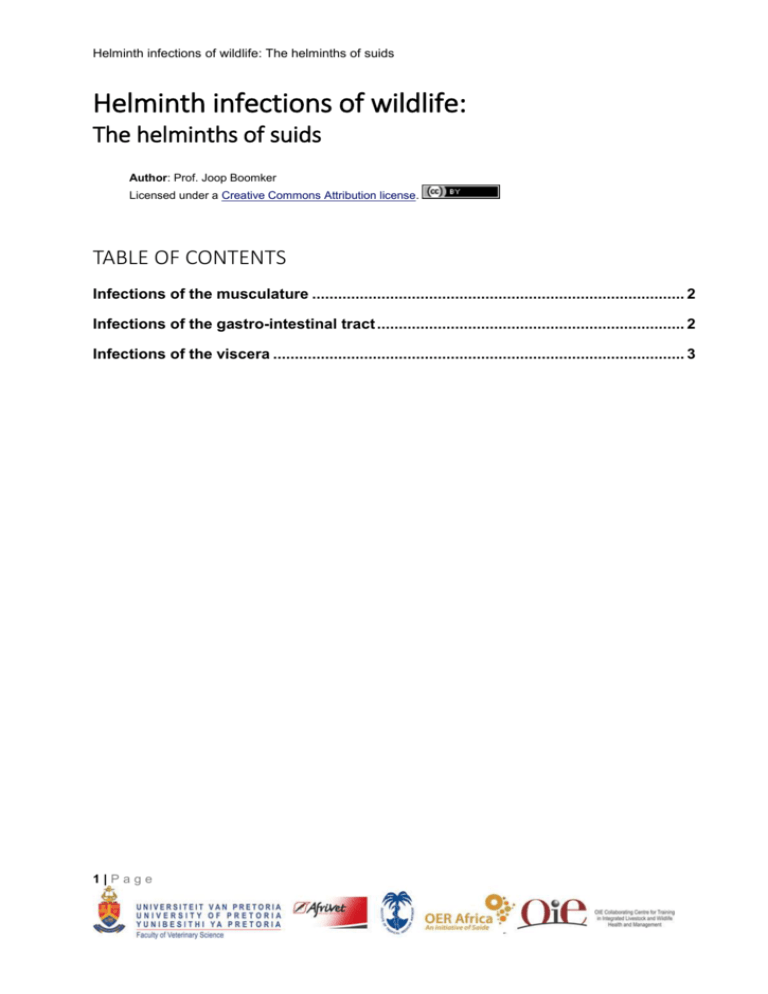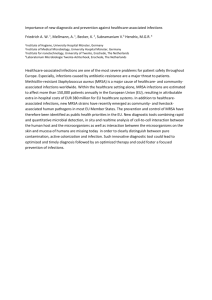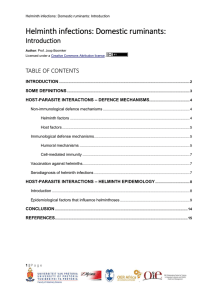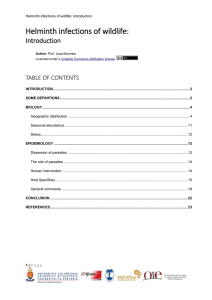04_helminths_wildlife_suids
advertisement

Helminth infections of wildlife: The helminths of suids Helminth infections of wildlife: The helminths of suids Author: Prof. Joop Boomker Licensed under a Creative Commons Attribution license. TABLE OF CONTENTS Infections of the musculature ...................................................................................... 2 Infections of the gastro-intestinal tract ....................................................................... 2 Infections of the viscera ............................................................................................... 3 1|Page Helminth infections of wildlife: The helminths of suids INFECTIONS OF THE MUSCULATURE In wildlife Trichinella spiralis has the sylvatic cycle which involves lion, spotted hyaena, black-backed jackal, multi-mammate mouse, warthog and Africa civet. South of the Sahara and especially in East Africa, Trichinella nelsoni appears to be the more important one in wildlife. Experimental infections of domestic pigs with T. nelsoni and T. spiralis from meat of wild animals in the KNP have indicated that the nematode can adapt, and may thus become an important zoonosis in future (Young & Kruger, 1967). Trichinellosis is largely asymptomatic in wildlife and man is the main sufferer. Adult worms in the intestine of humans cause nausea, diarrhoea and vomiting, and when the larvae enter the muscles, oedema of the eyelids and face occurs, and respiratory distress is sometimes seen. Taenia spp. metacestodes are sometimes seen, depending on how much contact there is with humans and their dogs, or wild carnivores. In large game reserves, the incidence and prevalence of muscle cysticercosis is low. Cysticerci of Taenia solium, Taenia hydatigena, Taenia crocutae, Taenia hyaenae and Taenia regis have been recorded (Round, 1968; Boomker et al., 1991). As is the case with cysticerci in domestic animals, little pathology is caused. INFECTIONS OF THE GASTRO-INTESTINAL TRACT Physocephalus sexalatus is a spirurid nematodes that utilizes an intermediate host, usually a dung beetle, in its life cycle. It occurs in the stomach of warthogs and bushpigs and only when present in massive numbers do they cause gastritis. The genera Oesophagostomum and Murshidia (Fig. 29) are large genera that contain numerous species and that are particularly abundant in elephants, rhinoceroses and wild pigs. Six species of Oesophagostomum, of which Oesophagostomum mocambiquei and Oesophagostomum mwanzae were the most common, and two of Murshidia have been described from the large intestine of warthogs and bushpigs and were present in vast numbers. An average of 35 000 for the former and 16 725 for the latter nematodes were recovered, a total of almost 52 000 worms per animal (Horak, Boomker, De Vos & Potgieter, 1988; Boomker, Horak, Booyse & Meyer, 1991b). Clinical oesophagostomosis was not reported and macroscopic lesions were limited to a few petechiae in the caecum and colon (Boomker, unpublished data, 1989). Ascaris phacochoeri was constantly found in surveys done in different parts of South Africa, and its prevalence varied from 30.7 to 57%. No reports of this nematode causing disease in free-living warthogs and bushpigs could be found. The anoplocephalid tapeworms Moniezia mettami and Paramoniezia phacochoeri are regularly encountered in young warthogs, in which they do not cause disease. The same applies to the trematode Gastrodiscus aethiopicus, which is also found in zebras. 2|Page Helminth infections of wildlife: The helminths of suids Fig. 30: The anterior part of Murshidia hamata illustrating the strongly developed oesophagus and head that is clearly set off from the rest of the body. INFECTIONS OF THE VISCERA A number of wild carnivores have been reported to have adult Echinococcus spp. worms, including black-backed jackal, Cape hunting dogs, hyaenas and lions (Verster & Collins, 1966; Young, 1975), and the wildlife cycles of Echinococcus spp. exists in the larger game reserves. The larger prey species, which are the antelope, warthogs and bushpigs act as intermediate hosts for the tapeworm, but the prevalence is not high. Eight warthogs out of the 52 examined in the KNP had hydatid cysts, a prevalence of 15.4%, while in the near-by Hoedspruit nature reserve, where the larger carnivores do not occur, the prevalence was only 3.6% (Horak et al., 1988; Boomker et al., 1991). The reason for the low prevalence is the absence of the carnivore final hosts, thus breaking the life cycle. It is also possible that the warthogs that harboured the hydatid cysts were from the KNP or even neighbouring, large private reserves where the carnivores occur. 3|Page








